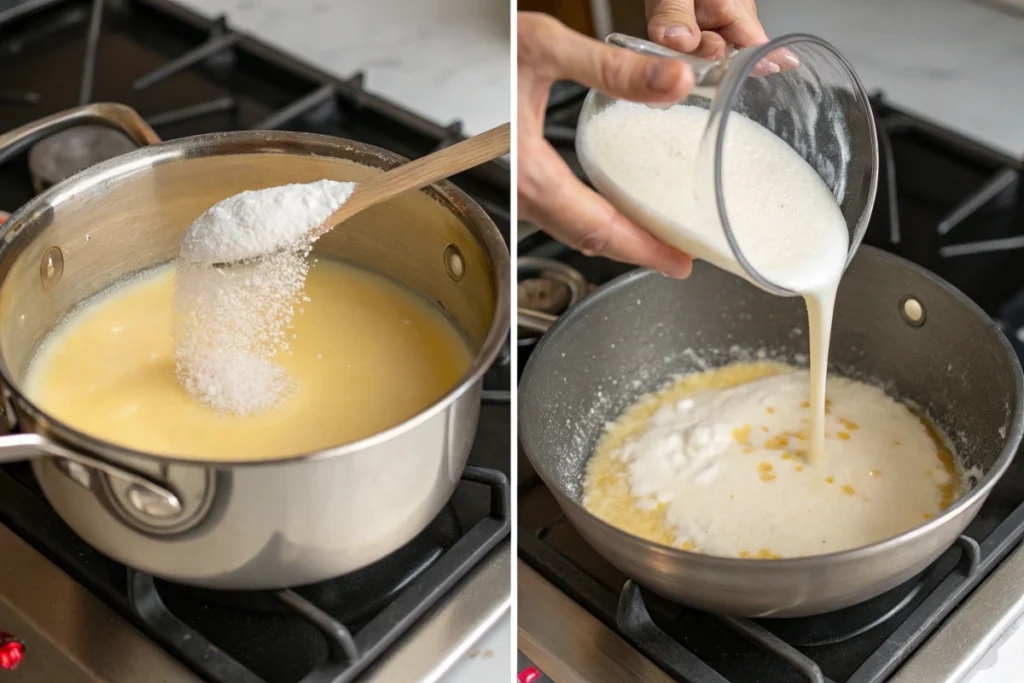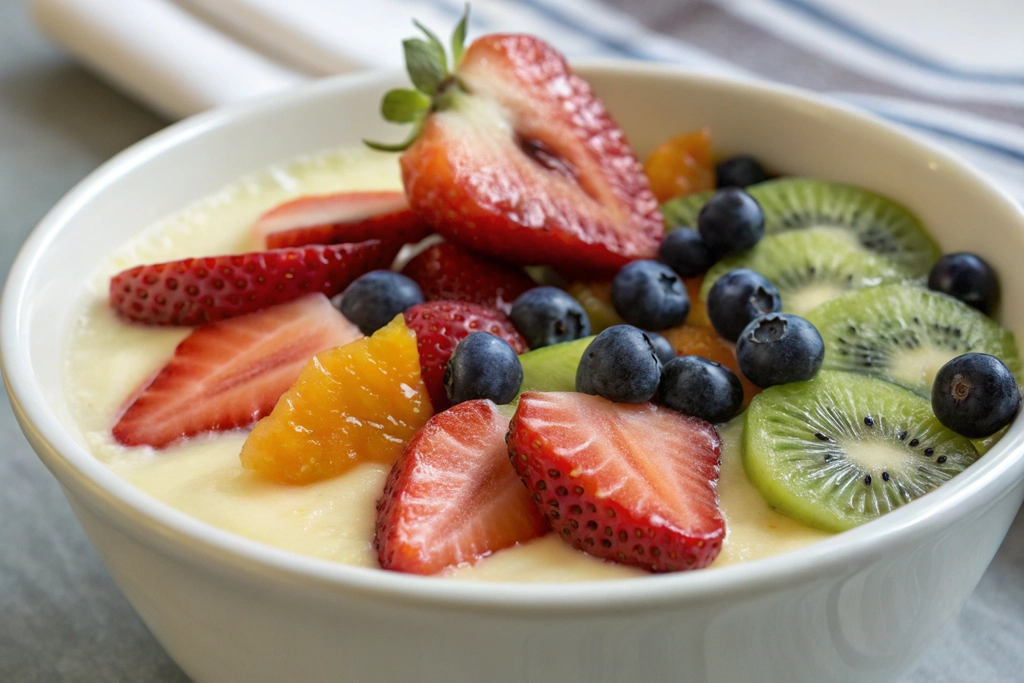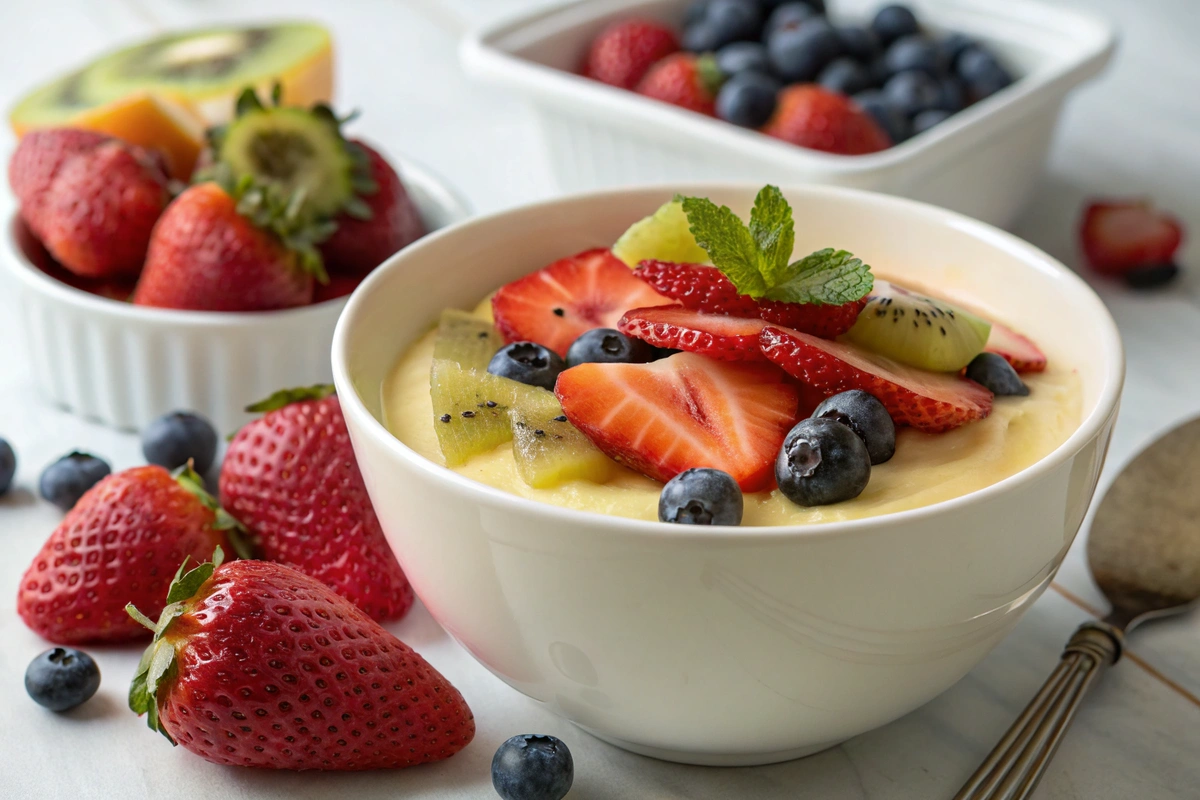Making desserts at home is a delight, and nata fruit pudding recipe offers a perfect blend of creaminess, sweetness, and a chewy texture that’s sure to impress. In this guide, we’ll dive into every detail of creating this unique dish. From its fascinating origins to step-by-step instructions, you’ll learn everything you need to prepare this refreshing pudding in your kitchen. Along the way, we’ll explore variations, health benefits, and tips to make your dessert stand out. Whether you’re a seasoned cook or a beginner, this article has something for you. Let’s get started!
Introduction to Nata Fruit Pudding
What is Nata Fruit Pudding?
Nata fruit pudding is a luscious dessert that combines the creamy texture of pudding with the delightful chewiness of nata de coco—a coconut jelly derived from fermented coconut water. This dessert is a hit in many Asian cuisines, often paired with fresh fruits to add a burst of flavor and color. It’s versatile, easy to prepare, and perfect for any occasion.
Brief History of Nata de Coco in Desserts
Did you know that nata de coco originated in the Philippines? The term itself comes from Spanish, where “nata” means cream and “de coco” means of coconut. This delicacy dates back to the 17th century when coconut water fermentation was developed as a food preservation method. Over time, its chewy texture and mild flavor made it a popular ingredient in desserts, drinks, and even salads across Southeast Asia and beyond.
Incorporating nata de coco into puddings has transformed traditional recipes into modern, creative treats. Its unique texture contrasts beautifully with the smoothness of the pudding, making every bite a delightful experience.
Understanding Nata de Coco – The Star Ingredient
What is Nata de Coco?
Nata de coco is a translucent, jelly-like food made from fermented coconut water. This chewy ingredient, often used in desserts and drinks, has a mild flavor that pairs well with other ingredients. Originating in the Philippines, it quickly became a beloved addition to recipes around the world. Thanks to its texture and versatility, it’s the key ingredient in the nata fruit pudding recipe, giving it a unique twist.
How is Nata de Coco Made?
The production of nata de coco starts with coconut water, which is fermented using a special bacterial culture called Acetobacter xylinum. During fermentation, the bacteria transform the coconut water’s sugar content into a gel-like cellulose layer, creating the distinctive jelly texture. After fermentation, the nata is cut into bite-sized cubes, thoroughly rinsed to remove any by-products, and then soaked in syrup for added sweetness.
Commercial producers often enhance nata de coco with various flavors, making it suitable for a variety of dishes, including the nata fruit pudding recipe. The process is simple but fascinating, combining natural fermentation techniques with a touch of culinary creativity.
Why Nata de Coco is Perfect for Pudding
What makes nata de coco stand out in pudding? Its chewy texture contrasts with the creamy base, creating a satisfying balance of flavors and sensations. Plus, nata de coco absorbs the flavors of the pudding, enhancing its overall taste. When used in the nata fruit pudding recipe, it adds both a visual appeal and a delightful chewiness that takes the dessert to the next level.
Essential Ingredients for Nata Fruit Pudding
List of Main Ingredients
To make a delicious nata fruit pudding recipe, you’ll need simple ingredients that come together beautifully:
- Nata de coco: The star of the show, bringing texture and sweetness.
- Milk: Whole milk or coconut milk for a creamy base.
- Cornstarch: A thickening agent that ensures the pudding sets perfectly.
- Sugar: For sweetness, with room to adjust based on your taste.
- Vanilla extract: To enhance the overall flavor.
- Salt: A pinch to balance the sweetness.
Alternative Ingredients for Dietary Preferences
If you’re looking to tweak the recipe, there are plenty of options. For a vegan-friendly pudding, swap out dairy milk for almond, soy, or oat milk. Prefer less sugar? Opt for a natural sweetener like maple syrup or agave nectar. You can also add fresh fruits like mangoes, berries, or kiwi to boost flavor and nutrition. The nata fruit pudding recipe is adaptable, making it easy to suit different tastes and diets.
Step-by-Step Recipe for Nata Fruit Pudding
Preparation of Ingredients
Before diving into the nata fruit pudding recipe, it’s essential to gather and prep your ingredients. Rinse the nata de coco thoroughly if it’s packed in syrup. This helps remove excess sweetness and ensures the jelly blends well with the pudding. Dissolve cornstarch in a portion of your chosen milk to create a smooth mixture. Preparing ahead makes the cooking process seamless and enjoyable.
Cooking the Pudding Base
To begin, combine the remaining milk, sugar, and a pinch of salt in a saucepan over medium heat. Stir consistently to prevent the sugar from settling at the bottom. Once the mixture is warm, gradually pour in the cornstarch solution while stirring continuously. This prevents lumps and ensures a velvety texture. Continue cooking until the mixture thickens into a pudding-like consistency, which usually takes about 8–10 minutes.

Incorporating Nata de Coco
Once the base is ready, remove it from the heat and stir in vanilla extract for added aroma. Allow the mixture to cool slightly before folding in the nata de coco. This step ensures the jelly remains firm and evenly distributed.
Tips for Setting and Serving
Pour the mixture into serving glasses or molds, then refrigerate for 2–3 hours. For a special touch, top your nata fruit pudding with fresh fruits like mango slices, kiwi, or berries. Serve chilled to enjoy its refreshing flavor.
Variations and Customizations of the Recipe
Using Different Fruit Toppings
The beauty of the nata fruit pudding recipe lies in its versatility. You can elevate the dessert with fruit toppings that add color and flavor. Tropical fruits like pineapple or dragon fruit provide a zesty contrast, while berries lend a sweet, tangy note.
Making it Vegan-Friendly with Substitutes
If you’re aiming for a plant-based version, swap dairy milk with coconut, almond, or soy milk. Adjust the sugar level to suit your preference, and ensure all additional ingredients are vegan-friendly. The natural flavor of nata de coco pairs beautifully with these alternatives.
Adding Flavors like Chocolate or Coffee
For a richer taste, consider incorporating melted chocolate or brewed coffee into the pudding base. These additions create a unique twist on the classic nata fruit pudding recipe, making it perfect for those who love bold flavors.
For more dessert inspirations, check out our recipe collection on Absolute Recipes.
Nutritional Benefits of Nata Fruit Pudding

Health Benefits of Nata de Coco
One of the standout features of the nata fruit pudding recipe is the inclusion of nata de coco, which is not only delicious but also nutritious. Made from coconut water, nata de coco is naturally low in calories and fat, making it a guilt-free treat. It’s high in dietary fiber, which aids digestion and promotes gut health. Additionally, the fermentation process enhances its nutritional value by adding probiotics that can support a healthy immune system.
Another perk? It’s gluten-free and vegan-friendly, so it suits various dietary needs. Whether you’re indulging in it as a dessert or a snack, nata de coco offers a healthful twist to your meals.
Nutritional Content of the Pudding
When you prepare the nata fruit pudding recipe, you’re creating a dessert that’s both satisfying and nourishing. The milk base, whether dairy or plant-based, is a great source of calcium and protein, supporting strong bones and muscle health. Using fresh fruits as toppings adds natural sugars, vitamins, and antioxidants, boosting the overall health quotient.
For those watching their sugar intake, the recipe can be easily modified with natural sweeteners or sugar substitutes. This makes the pudding a flexible and health-conscious choice for anyone with a sweet tooth.
Nutritional Breakdown of Nata Fruit Pudding
Here’s a neutral nutritional breakdown for one bowl (approximately 200g) of nata fruit pudding (values may vary based on exact ingredients and quantities):
| Nutrient | Approximate Value |
|---|---|
| Calories | 180–220 kcal |
| Carbohydrates | 35–40 g |
| Sugar | 18–25 g |
| Protein | 3–5 g |
| Fat | 3–7 g (depends on milk used) |
| Fiber | 2–4 g |
| Sodium | 50–80 mg |
| Calcium | 80–120 mg |
Notes:
- Calories and fat may increase if whole milk or additional toppings like caramel are used.
- Fiber comes primarily from nata de coco and added fruits.
- For a lower-calorie option, use almond milk or sugar substitutes.
FAQs About Nata Fruit Pudding
What fruit is nata?
Making the nata fruit pudding recipe is a quick and straightforward process. The preparation takes about 15 minutes, while the pudding needs 2–3 hours to set in the refrigerator. It’s an excellent make-ahead dessert for busy schedules or entertaining guests.
How to eat Scottish fruit pudding?
To enjoy Scottish fruit pudding, start by slicing it into thick pieces for even cooking. Next, fry the slices lightly in butter or oil until golden brown, enhancing their rich flavor. Then, pair it with a traditional Scottish breakfast, including eggs, bacon, and sausages, for a hearty meal. Alternatively, serve it as a sweet treat with jam or honey to complement its fruity, spiced notes.
What are the Best Fruits to Pair with Nata de Coco?
The nata fruit pudding recipe shines when paired with fresh fruits. Mango, kiwi, strawberries, and blueberries are popular picks, adding vibrant colors and refreshing flavors. Tropical fruits like pineapple or lychee also complement the chewy texture of nata de coco.
What is nata de coco pudding?
Nata de coco pudding is a creamy dessert that combines a smooth, milk-based pudding with chewy nata de coco jelly. Made from fermented coconut water, nata de coco adds a unique texture and subtle sweetness to the dish. Typically, it’s served chilled and often topped with fresh fruits for extra flavor and color. Furthermore, its versatility makes it a popular treat in many Asian-inspired recipes and beyond.
What are the cubes in cocon pudding?
The cubes in coconut pudding are typically nata de coco, a jelly-like ingredient made from fermented coconut water. These translucent, chewy cubes add a unique texture that contrasts beautifully with the creamy pudding. Additionally, they absorb the flavors of the dish, enhancing the overall taste. Often, nata de coco is paired with fruits or syrups to make the dessert even more delightful.
Conclusion
The nata fruit pudding recipe is a delightful and versatile dessert that combines creamy, smooth textures with the chewy goodness of nata de coco. With its simple ingredients and customizable options, it’s a perfect treat for any occasion, whether you’re hosting a dinner party or enjoying a quiet moment at home.
This dessert not only satisfies your sweet cravings but also brings nutritional benefits, thanks to its fiber-rich nata de coco and the added fruits. From vegan-friendly variations to creative serving ideas, the possibilities are endless.
Now it’s your turn to try this easy, crowd-pleasing recipe and impress your family and friends. Don’t forget to experiment with toppings and flavors to make it uniquely yours. Enjoy every spoonful of this refreshing dessert!

